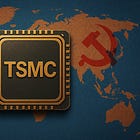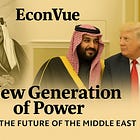Our Theme: Economic Security
On Nov 18, econVue convened panelists form Washington, Sydney, Taipei, and Chicago to examine the physical materials, including energy that are the foundation of the global economy— at a moment when globalization is giving way to mobilization.
The discussion explored AI’s massive physical footprint, mineral dependence, Indo-Pacific security dynamics, and the Middle East’s emerging role in AI supply chains. It was a fast-paced, information-packed hour. Highlights are below— I believe that listening to this panel will expand the knowledge base even of experts in the field.
We also announced the launch of the Hale Strategic Resources Initiative (HSRI), a new platform dedicated to rebuilding US industrial capacity and strengthening trusted supply networks across the Indo-Pacific. Follow us for more details, coming soon!
If you missed it, don’t forget to read panelist Karim Pakravan’s new essay, A New Generation of Power, AI and the Future of the Middle East — a deeper dive into the geopolitical and energy dynamics shaping AI.
And just a note: as always, questions from the audience are considered off the record and are not included in the video. Join us live next time!
💬 𝓁𝓎𝓇𝒾𝒸
Moderator:
Editor-in- Chief, econVue
📍Chicago
Panel Highlights
Mark P. Mills — The Physics Behind the Future
❝ Bits are not weightless. Every digital advance begins with digging something out of the ground.
Mark Mills opened by grounding the conversation in physical reality: AI is driving an unprecedented surge in demand for electricity, minerals, and industrial infrastructure. Gigawatt-scale data centers now under construction in the US require more steel and concrete than skyscrapers—and consume twenty times more annual energy than a comparable number of cars. Despite trillions spent on renewables, global reliance on oil, gas, and coal remains above 80% and is rising. Minerals, not ideology, are the binding constraint on any energy transition.
Eleanor Shiori Hughes — Alliances Without Treaties
❝ It’s everything short of a formal alliance—Japan, Australia, the U.S., and the Philippines are aligning because they must.
Eleanor Hughes highlighted deepening coordination between Japan, Australia, and the US around critical minerals, semiconductor security, and regional defense. Japan’s new leadership has taken a sharper line on Taiwan, increasing friction with Beijing. Both Tokyo and Canberra view rare earths and semiconductor resilience as national-security imperatives. The region is coalescing—not through new treaties, but through shared strategic necessity.
Mark Roeder — The Arrival of Embodied AI
❝ We’re living in the lull before the storm. Embodied AI will transform our physical world in the next few years.
Mark Roeder emphasized that AI’s next leap is not digital but physical—robots, multimodal systems, and manufacturing processes that merge software with hardware. China is positioned to dominate this shift, just as it did electric vehicles, because it controls the integrated supply chains. Australia, meanwhile, is reassessing its role, recognizing that its mineral base and strategic geography make it a critical partner in this new industrial era.
Eric Huang — Taiwan at the Center of Global Security
❝ US economic security depends on Taiwan’s physical security
Speaking from Taipei, Eric Huang underscored Taiwan’s irreplaceable role in global semiconductor manufacturing. While the US pushes for diversification, Taiwan fears losing too much capacity abroad—but understands that risk-sharing is essential. Taiwan’s engineering talent, manufacturing discipline, and tool-integration ecosystem cannot be replicated quickly. As AI’s energy and material demands grow, Taiwan sits at the geopolitical center of the global economy.
Karim Pakravan — The Gulf States Reposition Themselves
❝ The Gulf states are moving from oil-for-security to capital-for-supply-chains.
Karim Pakravan explained how Saudi Arabia, the UAE, and Qatar are pursuing influence by investing in AI infrastructure, energy-intensive industries, and minerals. They offer cheap energy and political flexibility—but lack skilled labor. With global investment shifting toward private credit, the scale of needed infrastructure raises new financial-stability risks. Uranium, long ignored, may emerge as one of the decade’s most strategic resources.
🔑 Key Takeaways
AI is physical, not virtual. Its infrastructure demands vast energy, land, minerals, and capital.
Minerals—not technology—are the bottleneck for energy transitions and electrification.
China controls 50–95% of refining for many critical minerals.
Japan and Australia are aligning more directly with the US on supply-chain security.
Taiwan remains the semiconductor center of gravity, essential to AI and global economic stability.
The Middle East seeks a new role in supply chains, blending capital, energy, and geopolitics.
Uranium is returning to the center of strategic planning as nuclear capacity grows.
Financing is shifting from traditional banking to private credit, increasing systemic risk.


























